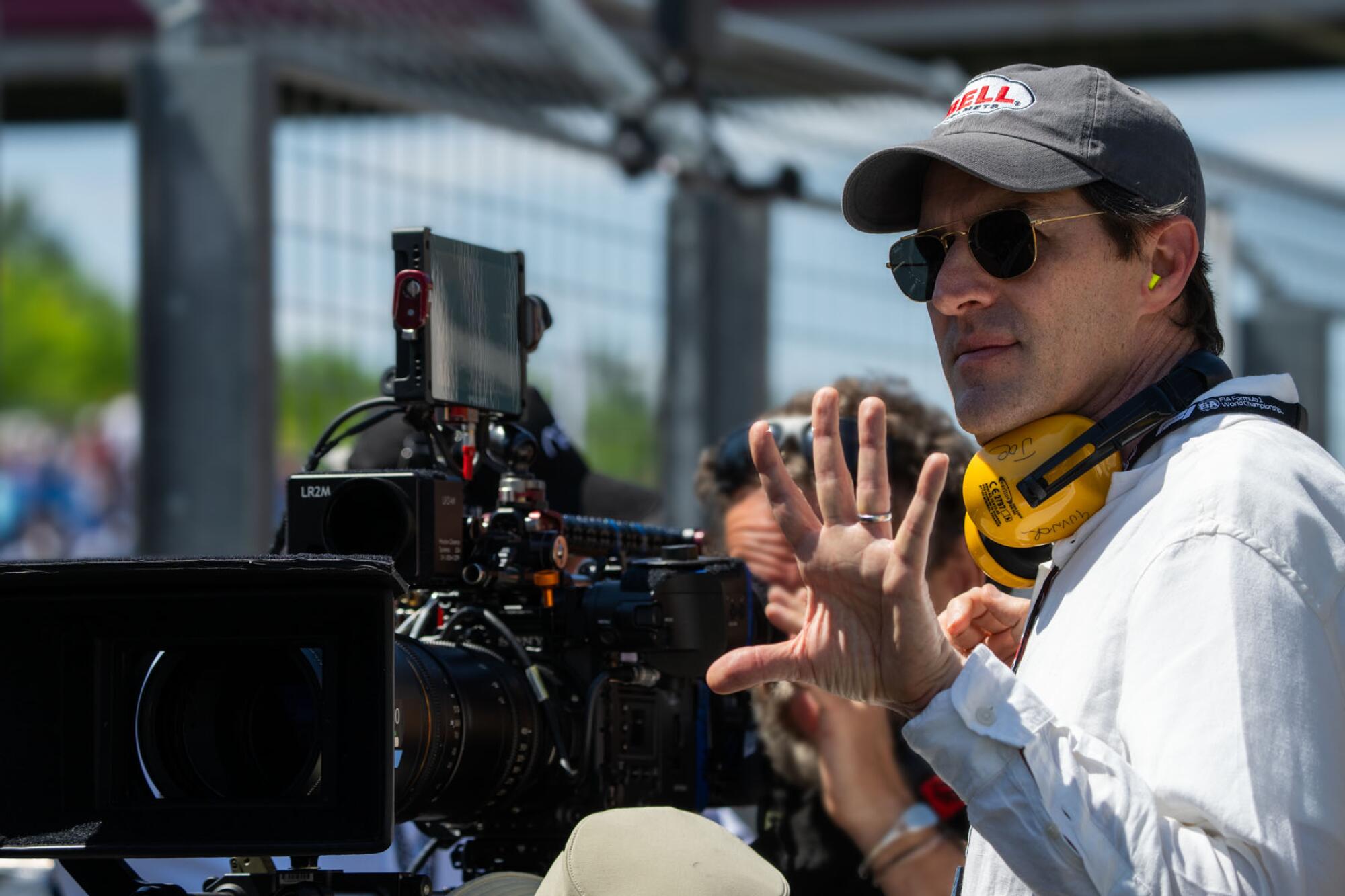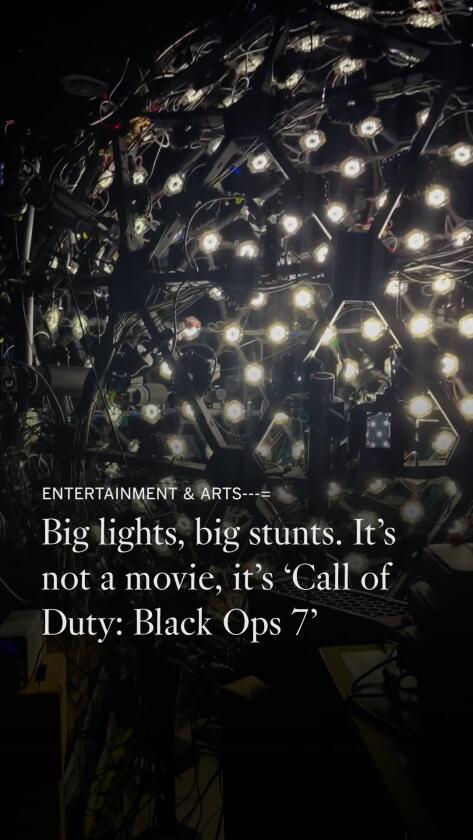Behind the scenes: How ‘F1’ made a movie at real F1 races
Joseph Kosinski didn’t want to direct “F1” unless he was able to do it the hard way. That was the germ of an idea for what would eventually become one of the biggest hits of 2025: Create a movie about an underdog Formula One team that didn’t fake being at F1 races, but actually became a part of them.
“It was kind of like, ‘Yes, this is a little insane,’” said Kosinski, “‘but if we can pull it off, we’ll get something totally unique.’”
Kosinski doesn’t present as your average adrenaline junkie. He’s mellow and looks like he could work at a bank — in fact, he pursued architecture before finding a calling in film as a David Fincher protégé. Kosinski was trusted with blockbusters from his debut, 2010’s “Tron: Legacy,” and in 2022 broke through with “Top Gun: Maverick,” which strapped Tom Cruise and other insurance liabilities into actual fighter jets as an alternative to relying on CGI.
“I think on ‘Maverick,’” Kosinski said, “I found out that the audience does appreciate when you shoot something for real. They can tell the difference between something done on a soundstage and done in a real situation. It’s something we are very attuned to and connect to.”
“F1” tells the story of Sonny Hayes (Brad Pitt), a leathery road dog of a driver who gets called back into Formula One by an old racing friend (Javier Bardem), who’s now the owner of a struggling team, desperate for a Hail Mary. The film is partially based in reality; the Hayes character is inspired by Martin Donnelly, whose promising career was cut short in 1990 by a gruesome crash. It’s also partially based in a fantasy in which someone old enough to have seen the 1966 epic “Grand Prix” in theaters would be allowed to sit in the driver’s seat of a modern F1 team.

Director Joseph Kosinski on the set of “F1.”
(Apple TV)
But the fantasy elements were designed to be offset by a hyperrealism that’s rarely afforded to film productions — not just in the ability to feature the actual teams and drivers, but also to film a significant portion of the movie at the races themselves. It helped that the production had Lewis Hamilton, one of the best drivers in the history of the sport, on board as a producer to help grease the wheels with the Fédération Internationale de l’Automobile, the governing body of F1. Even with Hamilton, though, Apple — which ultimately spent over $200 million on the movie — had to prove to the FIA that they could set up at an event like the fabled British Grand Prix at Silverstone and not cause a pileup.
“We had to rehearse the blocking and staging for about two weeks with a stopwatch in front of the FIA to prove to them that we could actually shoot a scene and get off the track before the race started,” said Kosinski, referring to a crucial scene when the characters played by Pitt and Tobias Menzies first meet.
Unlike “Maverick,” in which military pilots flew the jets, “F1” features driving from Brad Pitt and co-star Damson Idris, in some sense because it was the only way to get the shots they needed. “They’ve got four cameras in front of them that are whipping around and they’re having to do their lines and perform,” said Kosinski. “But mostly they’re trying not to die in front of 100,000 people.”
Every department — from the actors to craft services — had to learn how to operate at dangerous speeds and with higher stakes. Ben Munro, who did the production design with Mark Tildesley, explained that, normally, his department would have two weeks to build a set; in some cases on “F1,” such as a scene filmed at the McLaren headquarters, they would have just 12 hours, overnight.
“When you try to integrate with the real world, ultimate control becomes harder,” Munro said. “And as filmmakers, we’re used to being in ultimate control.”

The “F1” team developed new cameras to capture the film’s ultra-realistic high-speed racing.
(Apple TV)
The camera team too had to be adaptable and mobile (no VistaVision here), all while figuring out how to capture footage at 180 miles per hour that couldn’t be covered with more than a few takes. “First, we had to make a camera that didn’t exist yet,” said Claudio Miranda, the film’s cinematographer.
Miranda, who won an Oscar for “Life of Pi,” worked with Sony to develop small, agile “sensor-on-a-stick” cameras with Imax-worthy lenses to place around the cars. Coverage became essential — there were 16 camera positions to capture as much as possible. With both the racing itself and the hoopla around race weekend, the usual filmmaking mindset simply had to change: “I’m not always able to shoot sunset for this shot, or backlight for this quarter,” said Miranda, describing his thinking. “We traded all that in for the realism of the movie. But I think that’s unbeatable.”
Other than a few spinouts (and a stray Brad Pitt fan ruining a shot to get a selfie), the production was miraculously accident-free, despite taking almost two years to film. That may be due in part to the fact that, if you squint, it turns out that a film crew is similar enough to an F1 team to fit right in.
“Everyone had to be prepared for those nine-minute shoot windows in the same way that you’d have to be ready for a pit stop,” Kosinski said. “There was a really interesting kinship. And we really did feel like the 11th team after spending two seasons with them.”
The moment that sticks with Miranda is from the end of the production, in Abu Dhabi, when all the real F1 teams got their cars out for one grand scene together — a million-dollar setup, to undersell it by a few digits. “In the beginning, it did feel like we were this annoying little buzzard,” Miranda said. “I think that’s why I got really emotional when everyone wanted to help us out in the final race and bring the cars out. Because it felt like, at the end, we were kind of loved.”




